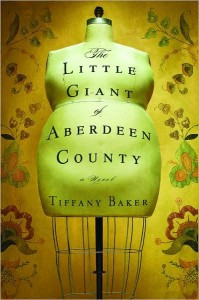 Tiffany Baker’s debut novel, The Little Giant of Aberdeen County, contains an apparent contradiction in its title: a little giant? Truly Plaice, the character so dubbed, is no Paul Bunyan: she doesn’t tower over rooftops or create canyons with her feet. But she’s plenty big enough to cause a stir: at five, she’s two inches taller than her seven-year-old sister, and she just keeps growing bigger and heavier. So she becomes known as Aberdeen’s “little giant,” a position that shapes her fate. And that oxymoron encapsulates this whimsical novel, which is, at its heart, about the yoking together of opposites.
Tiffany Baker’s debut novel, The Little Giant of Aberdeen County, contains an apparent contradiction in its title: a little giant? Truly Plaice, the character so dubbed, is no Paul Bunyan: she doesn’t tower over rooftops or create canyons with her feet. But she’s plenty big enough to cause a stir: at five, she’s two inches taller than her seven-year-old sister, and she just keeps growing bigger and heavier. So she becomes known as Aberdeen’s “little giant,” a position that shapes her fate. And that oxymoron encapsulates this whimsical novel, which is, at its heart, about the yoking together of opposites.
Nearly every relationship in the book falls into this category: Truly and her longtime friend Marcus (overly large woman; extremely small man); Truly and the town doctor, Robert Morgan (admitted murderer; resident healer); Truly and her childhood companion, Amelia (harbinger of change; passive acceptor). But the most obvious opposites—and the novel’s emotional core—are Truly and her sister, Serena Jane. Serena Jane is beautiful, popular, and tiny; Truly is ugly, insulted by everyone, and—well, giant. The extreme contrasts between the two sisters drive most of the book’s action. Orphaned in adolescence, Serena Jane ascends to a life of privilege as the foster daughter of town’s vicar, while Truly ends up on a ramshackle farm with a impoverished family of outcasts. As time passes, the paths of the two sisters become even more perfectly counterpointed. One becomes the town’s May Queen, while the other is openly mocked in the streets. One makes a marriage while the other appears doomed to spinsterhood. And finally, one runs away, while the other stays to see events through to their bitter and biting end.
Even before you’ve read The Little Giant, you can probably guess which sister is adulated and which is humiliated, which sister is ultimately revealed as weak and which finds immense strength to wield. The book occasionally subverts your expectations, but for the most part, characters fall neatly into one of two categories: Good or Bad. Kind or Cruel. Powerful or Powerless. If these pairings seem slightly simplistic, they match the book’s slightly-larger-than-life, tall-tale tone. Baker’s striving for just-over-the-top here, and life in Aberdeen County contains some deliciously quirky details: the townspeople who bet on the weight of a woman’s unborn baby; the platters, needlepoint pillows, and T-shirts commissioned by the mayor to commemorate each annual May Day Parade; five generations of town doctors, all named Robert Morgan. And of course, there’s the town’s original wise woman, Tabitha, who might have been a witch, and whose hidden “shadow book” is the most compelling mystery and most refreshing surprise in the book.
At times, the novel feels painted with overly broad strokes. Some of the characters—especially the townspeople—flirt with caricature, and occasionally the writing leans towards the overt. Anticipating a reunion with her sister, Truly remarks to a friend, “It’s Serena Jane coming home. I don’t know how I’m supposed to act with her anymore. I’ve missed her, but I feel like the sister I had is gone, and I don’t know who all’s coming home in her place.” Later, contemplating a sick man, Truly muses, “He was wasting away while I’d gotten a double helping of what the universe was serving, and it hadn’t killed me yet. Instead, it was teaching me to live.” The narrative sometimes mistakes contradiction for complexity, and the ending is at once overly neat and fraught with questions. As an emerging writer, Baker may still be learning to wield her finer brushes.
But The Little Giant of Aberdeen does what the best debut novels do: it attempts something bold, and it creates a little universe of its own. It’s a confident, promising start for a confident, promising novelist.
Further Resources
– Hear Tiffany Baker read an excerpt from The Little Giant of Aberdeen County on KQED Public Radio.
– Powell’s features an original essay by Baker, “When Size is in Your Imagination.”
– The author’s own website offers “Tiffany Baker’s Recipe for a Writing Life.”
– Baker also blogs for The Debutante Ball, a “group blog for debut novelists, now in its third season.”
– Here are interviews with Baker (about Little Giant) from Publisher’s Weekly, Curled Up with a Good Book, and Bookpage.






